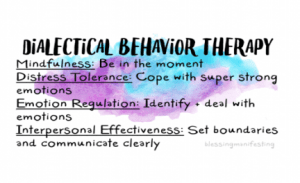DBT 2 – Putting it All Together Through Skills Practice
I. DBT Treatment Targets Hierarchy
- Address life-threatening behaviors such as suicidal and violent thoughts
- Identify and reduce therapy-interfering behaviors by client and therapist
- Target severe quality-of-life-interfering behaviors
- Build and reinforce skill development to address deficits
II. STOP Skills with TIPs
- STOP: Stop, Take a step back, Observe, Proceed mindfully
- TIPs: Temperature change, Intense exercise, Paced breathing
- Use in crisis moments to reduce emotional reactivity and regain control
III. Behavior Chain Analysis
- Identify triggers and consequences of problematic behaviors
- Increase insight into patterns maintaining emotional dysregulation
- Interrupt cycles through skillful replacement behaviors
IV. Emotion Regulation: PLEASE Skills
- PL: Treat physical illness
- E: Balanced eating
- A: Avoid mood-altering substances
- S: Sleep hygiene
- E: Regular exercise
- Connect physical health to emotional stability and well-being
V. Circle of Control Exercise
- Teach clients to differentiate between what they can and cannot control
- Reduce anxiety by focusing energy on manageable factors
- Enhance emotional regulation through empowerment
VI. Pros and Cons Skill
- Aid clients in evaluating options and making difficult decisions
- Help reduce impulsive behaviors by weighing short- and long-term outcomes
- Encourage clarity and self-reflection
VII. Radical Acceptance
- Teach acceptance of painful realities to reduce suffering
- Guide clients through writing acceptance letters
- Promote movement from resistance to adaptive action
VIII. DEAR MAN Interpersonal Effectiveness Skill
- D: Describe the situation
- E: Express feelings
- A: Assert needs
- R: Reinforce the request
- M: Be mindful
- A: Appear confident
- N: Negotiate
- Use for setting boundaries and advocating for oneself without conflict
IX. Case Studies for Skill Application
- Jackson & Toni: Addressing paranoia and relational stress
- Joan & Marie: Postpartum depression and identity regret
- Sarah: Self-injury, substance use, and emotional dysregulation
- Practice applying skills based on case needs and treatment goals
X. Summary and Integration
- DBT is structured around acceptance and change
- Each skill is a tool to reduce vulnerability and improve functioning
- Effective use of DBT builds a life worth living through emotional, behavioral, and interpersonal growth



